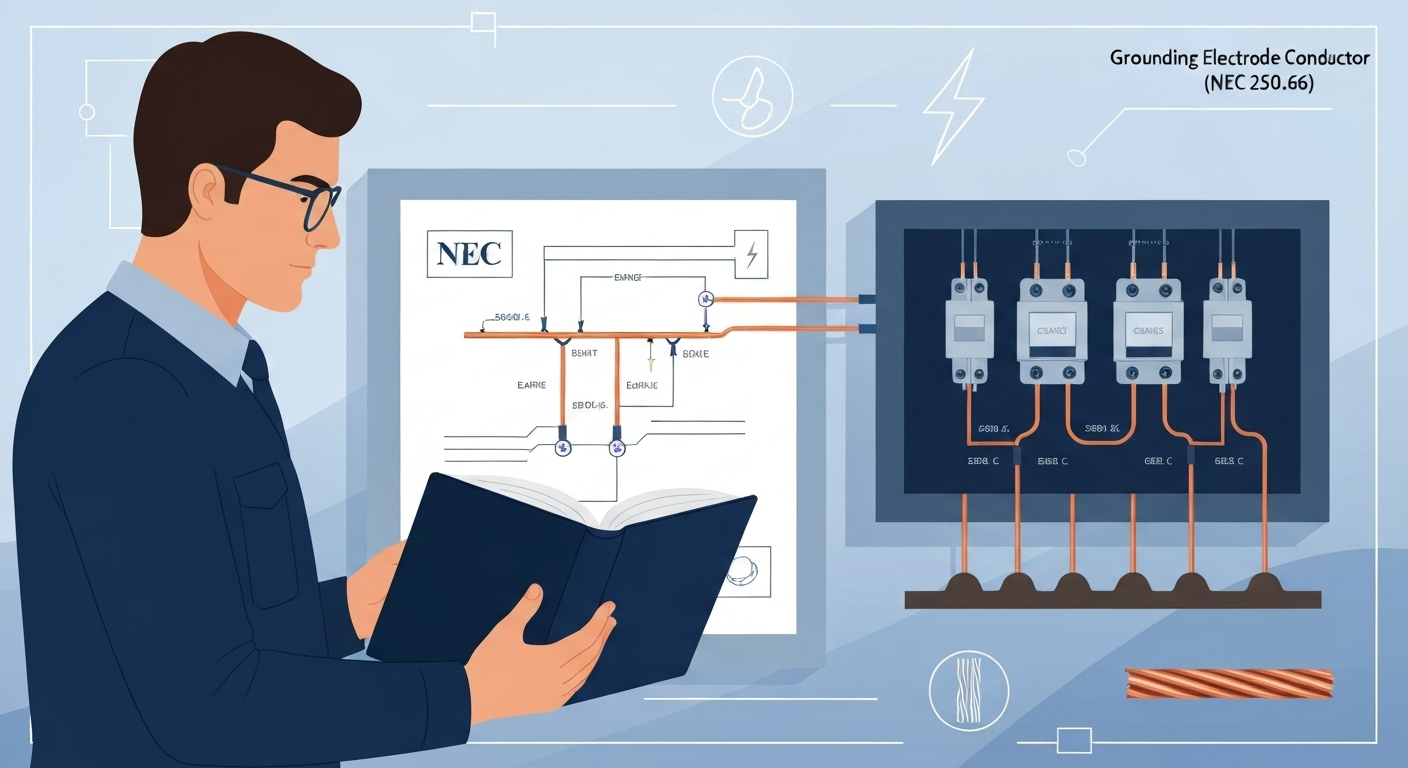
NEC 250.66 Grounding Electrode Conductor Sizing (2023 Update)
Properly sizing the Grounding Electrode Conductor (GEC) per NEC 250.66 is a fundamental skill for every licensed electrician. For most AC systems, the primary rule for NEC 250.66 grounding electrode sizing is to use Table 250.66. This table correlates the size of the GEC directly to the size of the largest ungrounded service-entrance conductor(s). For instance, a service with 500 kcmil copper service conductors requires a 1/0 AWG copper GEC. When service conductors are run in parallel, you must sum their circular mil areas to find the equivalent size before consulting the table. However, critical exceptions exist. If the GEC connects solely to a ground rod, pipe, or plate electrode, it is not required to be larger than 6 AWG copper. For a concrete-encased electrode (Ufer ground), the GEC is not required to be larger than 4 AWG copper. Mastering both the main table and these exceptions is essential for code-compliant installations.
The Foundation: Understanding the Grounding Electrode Conductor (GEC)
Before diving into sizing calculations, it’s crucial to be clear on what the Grounding Electrode Conductor is and what it does. The GEC is the vital link connecting the grounded service conductor, the main bonding jumper, and the equipment grounding conductor(s) at the service to the grounding electrode system. Its purpose is to connect the electrical system to the earth, which helps stabilize voltage during normal operation and provides a path for lightning and other high-voltage events.
This conductor is distinct from an Equipment Grounding Conductor (EGC), which provides a ground-fault current path from equipment back to the overcurrent protective device. Misunderstanding their roles can lead to dangerous and non-compliant installations. The GEC’s job is connecting to the earth; the EGC’s job is clearing faults.
The Primary Rule: Sizing with NEC Table 250.66
The default and most common method for grounding electrode conductor sizing is found in NEC Table 250.66. The principle is straightforward: the larger the service-entrance conductors, the larger the GEC needs to be to handle potential fault or event currents. The size is based on the total circular mil area of the largest ungrounded service-entrance conductor(s).
Step-by-Step Guide to Using Table 250.66
- Identify the Ungrounded Service-Entrance Conductors: Determine the size and material (copper or aluminum) of your ungrounded conductors supplying the service.
- Calculate Equivalent Area for Parallel Conductors: If the service conductors are installed in parallel (e.g., two sets of 3/0 AWG per phase), you must calculate their total equivalent area. Look up the circular mil area of one conductor in NEC Chapter 9, Table 8, multiply by the number of parallel conductors per phase, and then find the corresponding conductor size for that total area. This is the “Size” you’ll use in Table 250.66.
- Consult NEC Table 250.66: With the size of the largest service-entrance conductor (or equivalent area), find the appropriate row in Table 250.66.
- Select the GEC Size: The right-hand column of the table will specify the minimum required size for the copper or aluminum Grounding Electrode Conductor.
Example: A service is supplied by 500 kcmil copper ungrounded conductors. Looking at Table 250.66, the row for “Over 350 kcmil through 600 kcmil” for copper conductors specifies a minimum GEC size of 1/0 AWG copper.
Critical Exceptions to Table 250.66
While Table 250.66 is the primary rule, the NEC provides specific exceptions for connections to certain types of electrodes. These are not optional; they are distinct rules that apply in specific situations and are critical for cost-effective, compliant work.
250.66(A) – The Ground Rod Sizing Exception
This is arguably the most referenced exception. If the GEC connects to a rod, pipe, or plate electrode as defined in 250.52(A)(5) or 250.52(A)(7), the portion of the conductor that is the sole connection to that electrode is not required to be larger than 6 AWG copper (or 4 AWG aluminum). The key phrase here is “sole connection.” If your grounding electrode system consists of only one or two ground rods, a 6 AWG copper GEC is sufficient, regardless of how large your service conductors are.
250.66(B) – Connections to Concrete-Encased Electrodes
For a concrete-encased electrode (often called a “Ufer ground”), a robust and highly effective part of the grounding electrode system, the rules are also specific. Where the GEC connects to a CEE as described in 250.52(A)(3), it is not required to be larger than 4 AWG copper. Since a CEE provides a massive surface area connection to the earth, the code recognizes that a GEC larger than 4 AWG copper provides no additional benefit.
250.66(C) – Connections to a Ground Ring
When connecting to a ground ring meeting the requirements of 250.52(A)(4), the GEC is not required to be larger than the ground ring conductor itself. A ground ring must be at least 20 feet of bare copper, not smaller than 2 AWG, buried at least 30 inches deep. Therefore, if you install a 2 AWG ground ring, your GEC does not need to be larger than 2 AWG copper.
Key Takeaways for GEC Sizing
- Table 250.66 is the starting point. Always begin by assuming you’ll use the table unless a specific electrode exception applies.
- Know the exceptions by heart. The rules for ground rods (6 AWG Cu), CEEs (4 AWG Cu), and ground rings (conductor size) are used daily and are essential for correct installations.
- Sum parallel conductors. Never guess. Always perform the calculation for the equivalent area of parallel service conductors before using Table 250.66.
- Protect the conductor. Per NEC 250.64(B), the GEC must be protected from physical damage. This often involves installation in raceways like RMC, IMC, or EMT. Be sure to follow the specific protection and bonding requirements for these raceways.
- Differentiate GEC from other jumpers. The GEC connects the system to the earth. The Main Bonding Jumper and the Supply-Side Bonding Jumper have different roles and different sizing rules (see 250.28 and 250.102(C)). Understanding system bonding is critical, especially when dealing with unique setups like an impedance grounding system.
Mastering these electrical grounding rules is what separates a good electrician from a great one. The NEC is filled with calculations and tables that demand precision, from GEC sizing to more complex calculations like junction box fill. Staying current with the code and your state’s specific requirements is non-negotiable for safety and professional licensure, which is why resources that break down topics like Texas electrical license renewal are so valuable for career-long learning. Ready to deepen your code knowledge? Learn more with our NEC lessons.
Primary Sources
This article is based on the requirements found in the 2023 National Electrical Code (NFPA 70). For direct reference, consult the official codebook published by the National Fire Protection Association.
Frequently Asked Questions about NEC 250.66
What is the main rule for NEC 250.66 grounding electrode sizing?
The main rule for sizing a Grounding Electrode Conductor (GEC) is to use NEC Table 250.66. This table sizes the GEC based on the size (or equivalent area for parallel runs) of the largest ungrounded service-entrance conductor. The larger the service conductor, the larger the required GEC.
Can I always use a 6 AWG copper wire for a ground rod?
No, not always. According to NEC 250.66(A), a 6 AWG copper GEC is permitted only when it is the sole connection to a ground rod, pipe, or plate electrode. If that same GEC also connects to another electrode type that requires a larger conductor (like a metal water pipe that qualifies as an electrode), it must be sized according to Table 250.66 for the entire run.
How do I size a GEC for parallel service conductors?
When service-entrance conductors are installed in parallel, you must determine their equivalent total cross-sectional area. First, find the circular mil (cmil) area of a single conductor from NEC Chapter 9, Table 8. Multiply this value by the number of parallel conductors per phase. Finally, use this total cmil area to find the corresponding “Size of Ungrounded Conductor” in NEC Table 250.66 to determine the correct GEC size.
Does the GEC need to be protected from physical damage?
Yes. NEC 250.64(B) requires the Grounding Electrode Conductor to be securely fastened and protected from physical damage. If a GEC is 8 AWG, it must be installed in a raceway. If it’s 6 AWG or larger, it only requires a raceway or armor where exposed to physical damage. When a ferrous metal raceway is used, both ends must be bonded to the GEC to prevent it from acting as a choke.
Continuing Education by State
Select your state to view board-approved continuing education courses and requirements:
Disclaimer: The information provided in this educational content has been prepared with care to reflect current regulatory requirements for continuing education. However, licensing rules and regulations can vary by state and are subject to change. While we strive for accuracy, ExpertCE cannot guarantee that all details are complete or up to date at the time of reading. For the most current and authoritative information, always refer directly to your state’s official licensing board or regulatory agency.



